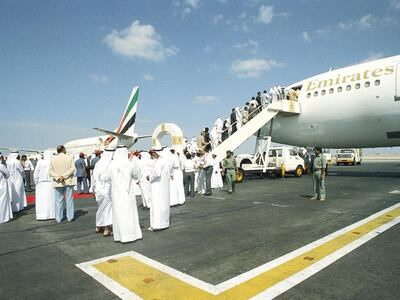It was an October morning with only a few clouds in the sky.
The Airbus A300 glided down the runway and soared above the city. Just another day at Dubai airport then. Well, not quite.
This was the first ever Emirates airline flight and it was headed for the Pakistani city of Karachi.
Those who saw the twin-engined jet with the UAE flag emblazoned on its tail fin take off on October 25, 1985, were watching history in the making.
But few could have possibly envisaged what Emirates would become in the 35 years since.
It is a story of ambition, hard work and a determination to believe in what others deem impossible.
Emirates’ first aircraft – an Airbus A300 and a Boeing 737 – arrived in Dubai on October 20 on lease from Pakistan International Airlines, which provided crucial assistance to the new airline.
"On the 18th of October a group of 100 pilots, flight and aircraft engineers, maintenance staff, among others, all came to Dubai to initiate the planning stages, and we began test flights from then on to ensure everything would operate to plan," said Capt Fazle Ghani Mian, the pilot of that inaugural EK600 flight to Karachi.
"I was also tasked to train UAE national pilots. They were trained in Dubai and got their commercial licenses from the Civil Aviation Authority in Pakistan."
The first flight took off at about 11:45am from Dubai.
"We had some great memories from the first flight. We pushed back and took off on time, and this signalled a great achievement for the airline in such a short period of time," he said.
Two other flights bound for Mumbai and Delhi took off the same day. And in the years since the growth of Emirates has been staggering.
On July 3, 1987, Emirates took delivery of its first owned aircraft, an Airbus A310. In its first five years of operations, Emirates grew its network to 14 destinations and by 1992 Emirates' order for seven Boeing 777s was a vote of confidence for the industry hit hard by the First Gulf War.
This ambition continued because by 2000, Emirates became the first airline to sign up for the Airbus A380. The double decker has become the backbone of the fleet in the years since as Emirates expanded to serve about 150 destinations around the globe.
Today Emirates is one of the world's leading airlines. And despite the challenges brought about by Covid-19, it has been rebuilding its network. It is currently operating to about 70 per cent of its original network.








